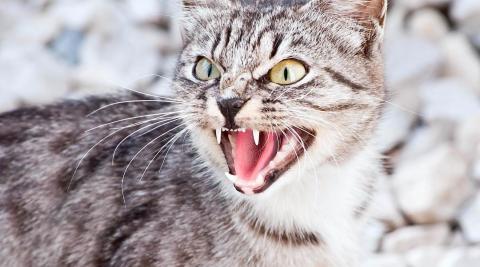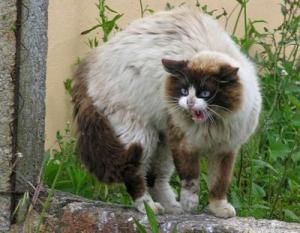Cat aggression is not common, but it can be a very serious issue. Learn how to identify and resolve feline aggression.

Cat aggression is actually not hugely common, but when a cat is aggressive it can be very frightening and dangerous for both the cat and the family!
There are several causes of cat aggression, and fortunately, it can often be resolved entirely or at least significantly improved. If your cat is very aggressive, take them to the vet to check that they are healthy and not in chronic pain. It is more helpful to think of the different causes of aggression separately, rather than just considering a cat to be aggressive in general. Cats are not aggressive by nature - their aggression is always a symptom of something else. It is by understanding the ‘something else’ that we can remove the cause of the aggression. Once the cause of the aggression is removed, then the aggression will no longer be needed by the cat, and will also stop.
Causes of cat aggression
-
Un-neutered stud cats
-
Fear aggression. Fear is a big cause of cat aggression.
-
Boredom aggression .
-
Pain aggression
-
Redirected aggression
-
Petting aggression
-
Territorial aggression

Un-neutered stud cats
Stud cats are cats that are used for breeding, although the same applies to any unneutered male cat. Strong hormones in a male cat simply amplify all of his reactions. So an unneutered stud cat is more likely to exhibit all of the other types of aggression. To make matters worse, stud cats are often kept on their own, in outdoor enclosures where they are often without any company (feline or human) and often lacking in stimulation. When a human enters the pen to clean the litter tray and feed them, this can cause problems because a) you are the only thing they have seen move in a long time, b) you are in their territory and they are not used to sharing it, and c) they are no longer used to human contact...add in the raging hormones and you have a problem. We will be writing a separate article on caring for stud cats, and how to keep them stimulated. For the purposes of this article, just know that the hormones of the cat and the circumstances in which they are kept exacerbate the common causes of cat aggression. You can try to improve the situation by following the recommendations for reducing cat aggression, but ultimately you may have to accept that your boy does not have the temperament to be a stud boy and have him neutered.
Fear cat aggression
This one is very primal: if a cat is afraid, he may be aggressive. As humans we should be able to understand this as ‘fight or flight’. A cat that is scared will have a surge of hormones that may lead him to being aggressive. A frightened cat will often crouch low to the ground, turn his body to the side but with his face and paws towards the cause of the fear, growl and hiss. A cat that is afraid will see all attempts to comfort him as further aggression. The solution is to leave the room, give him space (unless he is injured in which case you will need to take him to the vet). Nothing you can do will comfort a cat in this state.
-
Fear aggression at the vet: use a cat carrier that the top lifts completely off, to make it easier for the vet. Explain the situation to the vet so they can have a nurse with them to help handle your cat. Bring cat treats - these are used to create positive association and hopefully reduce your cats fear over time (it will be a slow process!)
-
Fear aggression toward another cat: separate them and then re-introduce them very slowly..see our article on how to introduce a new cat the right way
-
Fear aggression towards a human: often a new spouse or partner. Take this very slowly. Make sure the cat always has an escape route. Here are a few things the family member can do to improve the situation:
-
She should always put the cat’s food out, so the cat starts to associate the human with food, which is a positive association.
-
She should also give the cat treats (but not if he is hissing and exhibiting extreme aggression)
-
She can also engage in interactive play with the cat, when the cat is ready for this.
-
Often, cats do not like a person towering over them. If it safe, try sitting on the floor so you look less threatening.
-
Boredom cat aggression
Cats are natural hunters. They have hunting instincts. In a natural environment, they would find mice, flies, frogs and birds to hunt. If your cat is an indoor cat then you may well be the only thing that is actually moving within his environment. If this is the case, you may find that you become the ‘prey’ and the subject of your cat’s hunting instincts. Telltale signs of this type of aggression are:
-
Your cat is stalking you
-
Your cat pounces on your feet as you walk along
-
Your cat pounces on your hands when you are moving them (e.g. cleaning, typing etc)
-
Basically, if your cat stalks you and pounces on you, particularly when you are moving, then it is probably boredom aggression
There are some simple ways to deal with this:
-
If you only have one cat, consider introducing another (but be very mindful of infectious conditions, always quarantine the newcomer and remember to introduce the new cat properly). Provided you introduce them correctly, the two cats should then play with each other, and your feet will no longer be the most interesting thing in the house
-
If you have more than one cat already, or don’t want another cat, then you have to make your cat’s environment much more interesting.
-
Engage in active play with him (always with toys, never with your hands or feet)
-
Try electronic/automatic toys to keep your cat entertained, particularly if you are out for long periods of time
-
Try using feeding toys for your cat
-
Hide morsels of food for your cat to find
-
-
Try not to react when your cat pounces on you
-
Reward your cat when he behaves well and plays nicely with you, or sits nicely beside you etc
Pain cat aggression
Like us, cats in pain get grouchy. More than that, they feel threatened because they are weakened. That is why any aggressive cat should be checked by a vet - in case it is a symptom of pain. Clearly, if you inflict pain on a cat, even if it is by accident, the cat may strike out at you. This can often happen during grooming, vet visits, rough handling, children playing, tail pulling, etc. The solution is quite simple: be more gentle! Educate children in how to handle cats, or keep them apart.
Redirected cat aggression
This is common in multi-cat households, and especially in cat rescues. A cat hears a screech, a loud noise, or sees a fight, and suddenly lashes out at whatever is next to him: which may be another cat, or may be you! Basically what is happening is that the cat is aroused, or reactive, but is not able to respond to the proper cause of that, so lashes out at someone else. This could even happen during a vet visit: the cat is stressed by the vet visit and as you try to soothe him, he redirects his stress at you and strikes out at you. The solution is to separate the cat from you and other animals in the household, and let them calm down. If he struck at you at the vets, leave him in a room on his own for a while when you get home. This is not a punishment, it is to allow him time to calm down and come out of his alarmed or emergency state. If he lashes out at another cat, separate them for a while. If it is a frequent occurrence, separate the cats for a few days and start to re-introduce them from scratch.
Petting cat aggression
You are stroking your cat, who you think is loving the attention, and then WHAM! He strikes! This is a common issue. The key to dealing with this is to learn to understand your cat better. He WILL have exhibited signs of frustration and annoyance before he struck you, but because you are a human and not a cat, you missed the signs. Watch for tails flicking, ears being drawn back, and tension rising. If you’re not good at reading his body language, stroke him only for a short time, then give him a break.
Territorial cat aggression
In the wild, cats are lone rangers, and territorial creatures. All wild cats live alone, with the exception of lionesses who hunt in packs. Cats have therefore evolved to protect their own turf. Their territory provides their habitat and their dinner! Territorial aggression in cats is therefore a very primal thing, and it can be directed at other cats or at humans. Where there are favourite spots in the home, try to create similar spots elsewhere - for example, if there is a cat tower being fought over buy another one that is the same. If cats start to become territorial, engage them in active play before the tension builds too much. Give them treats when they interact well together, to encourage that behaviour. Create a variety of spaces around your home that have ‘cat appeal’, and make sure there are plenty of hiding places where cats will feel secure.
Read more....
- why your cat is pooing on the floor
- environmental enrichment for cats
- Pet Product Reviews: iPad game for cats
- when to neuter your male cat